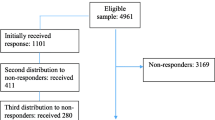Abstract
The present research was conducted to investigate the effects of mild levels of depression, and cognitive vulnerability to depression, on people's perceptions of their similarity to others. Depression level was assessed using the Beck Depression Inventory, and cognitive vulnerability was measured with the Dysfunctional Attitude Scale. Subjects rated their similarity to others on a 7-point scale and also generated a list of attributes thought to typify the “average other person.” In terms of similarity judgments, individuals perceived themselves to be less similar to others as depression level increased. Furthermore, and also as predicted, only individuals scoring high on the vulnerability measure exhibited this pattern. Given the consistently positive view of others expressed by all subjects, this latter finding suggests that vulnerable individuals saw themselves as increasingly distinctive with respect to their own negative attributes, as depression level increased. This social comparison interpretation is consistent with previous research indicating that vulnerable individuals change from a focus on self-referent positive traits when nondepressed to a focus on negative traits when depressed. This pattern is also identified as a possible contributor to the social isolation and interpersonal difficulties characteristic of depression.
Similar content being viewed by others
References
Beck, A. T. (1972). Measuring depression: The depression inventory. In T. A. Williams, M. M. Katz, & J. A. Shield (Eds.),Recent advances in the psychobiology of the depressive illnesses (pp. 299–302). Washington, D.C.: U.S. Government Printing Office.
Beck, A. T., & Beamesderfer, A. (1974). Assessment of depression: The depression inventory. In P. Pichot (Ed.).Psychological measurements in psychopharmacology and modern pharmacopsychiatry. Basel, Switzerland: Karger.
Beck, A. T., Rush, A. J., Shaw, B. F., & Emergy, G. (1979).Cognitive therapy of depression. New York: Guilford Press.
Beck, A. T., Ward, C. H., Mendelson, M., Mock, J., & Erbaugh, J. (1961). An inventory for measuring depression.Archives of General Psychiatry, 4 561–571.
Billings, A. G., & Moos, R. H. (1983). Psychosocial theory and research on depression: An integrative framework and review.Clinical Psychology Review, 2 213–237.
Bumberry, W., Oliver, J. M., & McClure, J. N. (1978). Validation of the Beck Depression Inventory in a university population using psychiatric estimates as the criterion.Journal of Consulting and Clinical Psychology, 46 150–155.
Byrne, D. (1971).The attraction paradigm. New York: Academic Press.
Coyne, J. C. (1976). Toward an interactional description of depression.Psychiatry, 39 28–40.
Derry, P. A., & Kuiper, N. A. (1981). Schematic processing and self-reference in clinical depression.Journal of Abnormal Psychology, 90 286–297.
Dobson, K. S., & Breiter, H. J. (1983). Cognitive assessment of depression: Reliability and validity of three measures.Journal of Abnormal Psychology, 92 107–109.
Eaves, G. & Rush, A. J. (1984). Cognitive patterns in symptomatic and remitted unipolar major depression.Journal of Abnormal Psychology, 93 31–40.
Festinger, L. (1954). A theory of social comparison processes.Human Relations, 7 117–140.
Holmes, D. S. (1987). Projection as a defense mechanism.Psychological Bulletin, 85 677–688.
Ingram, R. E., & Smith, T. W. (1984). Depression and internal versus external focus of attention.Cognitive Therapy and Research, 8 139–152.
Kuiper, N. A., & MacDonald, M. R. (1982). Self and other perceptions in mild depressives.Social Cognition, 1 223–239.
Kuiper, N. A., & McCabe, S. B. (1985). The appropriateness of social topics: Effects of depression and cognitive vulnerability on self and other judgments.Cognitive Therapy and Research, 9 371–379.
Kuiper, N. A., Olinger, L. J. (1986). Dysfunctional attitudes and a self-worth contingency model of depression. In P. C. Kendall (Ed.),Advances in cognitive-behavioral research and therapy (Vol. 5, pp. 115–142). New York: Academic Press.
Kuiper, N. A., Olinger, L. J., MacDonald, M. R., & Shaw, B. F. (1985). Self-schema processing of depressed and nondepressed content: The effects of vulnerability to depression.Social Cognition, 3 77–93.
Lazarus, R. S., & Folkman, S. (1984).Stress appraisal and coping. New York: Springer.
McGuire, W. J., & McGuire, C. J. (1981). The spontaneous self-concept as affected by personal distinctiveness. In M. D. Lynch, A. A. Norem-Hebeisen, & K. J. Gergen (Eds.),Self-concept: Advances in theory and research (pp. 147–171). Cambridge, Massachusetts: Ballinger.
Metee D. R., & Smith, G. (1977). Social comparison and interpersonal attraction: The case for dissimilarity. In J. M. Suls & R. L. Miller (Eds.),Social comparison processes: Theoretical and empirical perspectives (pp. 69–101). Washington, D. C.: Hemisphere.
Oliver, J. M., & Baumgart, E. P. (1985). The Dysfunctional Attitude Scale: Psychometric properties and relation to depression in an unselected adult population.Cognitive Therapy and Research, 9 161–167.
Ross, L., Greene, D., & House, P. (1977). The false consensus phenomenon: An attributional bias in self-perception and social perception processes.Journal of Experimental Social Psychology, 13 279–301.
Srull, T. K., & Gaelik, L. (1983). General principles and individual differences in the self as habitual reference point: An examination of self-other judgments of similarity.Social Cognition, 2 108–121.
Tabachnik, N., Crocker, J., & Alloy, L. B. (1983). Depression, social comparison and the false consensus effect.Journal of Personality and Social Psychology, 45 688–699.
Weissman, A. N. (1980).Assessing depressogenic attitudes: A validity study. Paper presented at the 51st Annual Meeting of the Eastern Psychological Association, Hartford, Connecticut.
Weissman, A. N., & Beck, A. T. (1978).Development and validation of the Dysfunctional Attitude Scale: A preliminary investigation. Paper presented at the American Educational Research Association Annual Convention, Toronto, Canada.
Author information
Authors and Affiliations
Rights and permissions
About this article
Cite this article
Swallow, S.R., Kuiper, N.A. The effects of depression and cognitive vulnerability to depression on judgments of similarity between self and other. Motiv Emot 11, 157–167 (1987). https://doi.org/10.1007/BF00992341
Issue Date:
DOI: https://doi.org/10.1007/BF00992341




